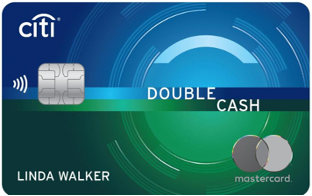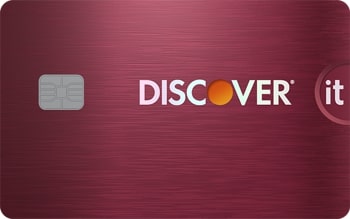Citi Double Cash Review: A Solid Choice for Everyday Spending
The Bottom Line
4.9
Although the market has started to catch up, this remains one of the better top-of-wallet cards. Use it by itself every day, or as a companion to bonus category cards.

Rates, fees and offers
Rates, fees and offers
Annual fee
$0
Rewards rate
2%-5%
Bonus offer
Earn $200 cash back after you spend $1,500 on purchases in the first 6 months of account opening. This bonus offer will be fulfilled as 20,000 ThankYou® Points, which can be redeemed for $200 cash back.
Intro APR
0% intro APR on balance transfers for 18 months
Ongoing APR
APR: 18.24%-28.24% Variable APR
Cash Advance APR: 29.49%, Variable
Penalty APR: Up to 29.99%, Variable
Balance transfer fee
Intro fee 3% of each transfer ($5 min) completed within the first 4 months of account opening. After that, 5% of each transfer ($5 min).
Foreign transaction fee
3%
More details from Citibank
More details from Citibank
- Earn $200 cash back after you spend $1,500 on purchases in the first 6 months of account opening. This bonus offer will be fulfilled as 20,000 ThankYou® Points, which can be redeemed for $200 cash back.
- Earn 2% on every purchase with unlimited 1% cash back when you buy, plus an additional 1% as you pay for those purchases. To earn cash back, pay at least the minimum due on time. Plus, earn 5% total cash back on hotel, car rentals and attractions booked with Citi Travel.
- Balance Transfer Only Offer: 0% intro APR on Balance Transfers for 18 months. After that, the variable APR will be 18.24% - 28.24%, based on your creditworthiness.
- Balance Transfers do not earn cash back. Intro APR does not apply to purchases.
- If you transfer a balance, interest will be charged on your purchases unless you pay your entire balance (including balance transfers) by the due date each month.
- There is an intro balance transfer fee of 3% of each transfer (minimum $5) completed within the first 4 months of account opening. After that, your fee will be 5% of each transfer (minimum $5).

Pros and Cons
Pros
No annual fee
High rewards rate
Intro balance transfer fee
Cons
No intro APR period on purchases
Detailed Review
The Citi Double Cash® Card is a valuable workhorse among credit cards. With superior flat-rate cash back, it’s ideal for consumers who want low-hassle cash rewards on everything they charge. What it lacks in sizzle, it makes up for in daily dependability. It’s a Honda Accord in a credit card market that's lately gotten jammed with Lamborghini wannabes.
Most of what you need to know: The card gives you 2% cash back on every purchase — 1% when you make it, and another 1% back when you pay it off. Rewards are unlimited, and the annual fee is $0.
The Citi Double Cash® Card stands up well on its own, but it also makes an ideal companion to a bonus-category credit card for those who use a two-card strategy to maximize cash back. And you can transfer rewards to a handful of partners to potentially snag outsize value.
On the downside, the card offers no 0% introductory period for purchases, which is nearly table stakes for top-tier cash back cards. Even so, to get good, reliable rewards with minimum effort (or cost), this card should be among the top few you consider.
Citi Double Cash® Card: Basics
Card type: Cash back.
Annual fee: $0.
Sign-up bonus: Earn $200 cash back after you spend $1,500 on purchases in the first 6 months of account opening. This bonus offer will be fulfilled as 20,000 ThankYou® Points, which can be redeemed for $200 cash back.
Rewards: 2% cash back on purchases, distributed in two stages:
1% back for every dollar spent.
1% back for every dollar paid off.
Cardholders also get 5% total cash back on hotels, car rentals and attractions when they book through Citi's portal.
Technically, rewards earned on the Citi Double Cash® Card appear in a cardholder's account as Citi ThankYou points, but that will not affect your ability to earn or redeem cash back. You'll earn 1 point per $1 spent and 1 point per $1 paid off. Points are worth 1 cent apiece when redeemed for cash back, meaning you'll still get 2% cash back on purchases. See here for more information.
Redemption options: Statement credit, bank account deposit or a check. You can also transfer your points to a handful of partners, including JetBlue, Wyndham and more.
Interest rate: 0% intro APR on balance transfers for 18 months, and then the ongoing APR of 18.24%-28.24% Variable APR.
Balance transfer fee: 3% of the amount transferred or $5 (whichever is greater) for transfers completed within the first four months of account opening; 5% fee or $5, whichever is greater, after that.
Foreign transaction fee: 3%.
Compare to Other Cards

Vacation more, spend less. Subscribe to our free newsletter for inspiration, tips, and money-saving strategies – delivered straight to your inbox.
By signing up, you will receive newsletters and promotional content and agree to our Terms of Use and acknowledge the data practices in our Privacy Policy. You may unsubscribe at any time.
Benefits and Perks
High rewards rate
The industry standard for cash back used to be 1%. As its name implies, the Citi Double Cash® Card essentially doubles that rate, paying 1% back on purchases and 1% after paying the bill. The sooner you pay your balance, the sooner you earn the second half of the rewards. That's a powerful incentive to pay your credit card bill in full every month, which we recommend you do anyway to avoid interest.
While we still think this is a fine card, it’s not quite the industry unicorn it used to be. Other cards also offer 2% cash back or more on purchases.
When you redeem cash back for a credit on your statement, you don’t earn the second 1%. That’s because you’re not actually paying off that amount; it’s just subtracted from your bill. But that’s a minor consideration. Redeeming a hefty $1,000 per year would mean forgoing $10 in rewards for the convenience of taking the money in the form of a statement credit. That’s still very close to a 2% return on spending, assuming you pay your bill in full every month.
Simplicity
Many cash-back cards offer bonus categories — some of them permanent, some that change from time to time and some that adjust with your spending. They allow you to earn extra rewards in featured categories, such as gas stations, restaurants and home improvement stores. They can be a hassle to keep track of. Some limit the amount of spending eligible for bonus rewards, and all spending over that limit earns a mundane 1% cash back.
With the Citi Double Cash® Card, you can be a lazy optimizer and whip out the same card all the time, without thinking about where you’re using the card and whether you’ve reached the limit for a bonus spending category. That said, there's one opportunity to earn extra rewards: 5% total cash back on hotels, car rentals and attractions when you book through Citi's portal.
Flexibility
Even though the Citi Double Cash® Card is considered a cash-back credit card, technically what you're earning are Citi ThankYou points. And while those points can easily be turned into cash at a rate of a penny each, they could potentially be even more valuable when used for travel.
The card features a handful of travel partners, including JetBlue, Wyndham and Choice Privileges, and depending on your credit card strategy and travel goals, this conversion flexibility could potentially increase the value of your rewards, should you find a good deal on flights or hotels with those partners.
That's especially true if you happen to hold multiple Citi cards because you can combine points across them all. While the Citi Double Cash® Card features only a few transfer partners, other Citi products — like the Citi Strata Premier® Card or Citi Prestige® Card — feature more than a dozen.
The Citi ThankYou rewards program is not as straightforward as others and requires a little know-how to navigate in order to get the best value. For example, transfer ratios with the Citi Double Cash® Card are less than favorable: 1,000 ThankYou points would get you only 800 points with JetBlue or Wyndham.
MORE NERDY PERSPECTIVES
 | This card has been at the top of my wallet since 2015 because of its high cash-back rate and uncomplicated rewards structure. It's definitely a card you want to pay in full every month, though. Half of the rewards are earned when you spend and the other half are earned when you pay your balance, so rewards will be delayed if you carry a balance. (Interest charges will also accrue when you carry a balance, potentially canceling out the value of the rewards.) Claire Tsosie, editor, travel rewards |
 | This is my catch-all card for any purchase that doesn't already fit neatly into a bonus category: medical bills, vet bills, oil changes, school fees, stores that I don't have a better option for. With Double Cash, I won't do any worse than 2% back. Kenley Young, editor, credit cards |
 | This is my "everything else" card that I use for anything that doesn't earn bonus cash back on other cards. My only real complaint is "latency." The 2% cash back is paid out in two parts, and rewards are slow to post: Your rewards balance can be up to two months behind your rewards earnings. Paul Soucy, content director, credit cards and travel rewards |
Drawbacks and Considerations
No everyday bonus categories
Double cash on all purchases is great, but it’s less than you’ll find on cards that offer elevated rewards on spending at everyday places like restaurants, supermarkets or gas stations.
Indeed, some cards offer 5% back on bonus categories that change quarterly. In the past, categories have included gas stations, restaurants, supermarkets, Amazon.com and PayPal. Good examples are the Chase Freedom Flex® and the Discover it® Cash Back. Both offer 5% back on categories that you activate, on up to $1,500 in spending per quarter (enrollment required), and 1% on all other spending.
Other cash-back cards have bonus categories that don't change. The Blue Cash Everyday® Card from American Express is a good example. The card earns 3% cash back* on up to $6,000 spent per year in each of three categories: U.S. supermarkets, U.S. gas stations and U.S. online retail purchases. Other spending earns 1% cash back. Terms apply (see rates and fees). It has an annual fee of $0.
By contrast, bonus rewards on the Citi Double Cash® Card are limited to certain travel bookings when done through Citi.
For optimizers, the decision is not either-or, but both. Boost cash rewards by using a bonus-categories card to get higher earnings on certain purchases, and use the Citi Double Cash® Card for everything else. That reaps a superior return with a little more effort.
And some cards offer a combination: a good flat rate on most purchases, a sign-up bonus and bonus categories. Example: The Chase Freedom Unlimited®.
Flat rate: 1.5%
Bonus category rewards: 3% cash back on dining at restaurants and drugstore purchases and 5% on travel purchased through Chase.
Sign-up bonus: Intro Offer: Earn a $200 Bonus after you spend $500 on purchases in your first 3 months from account opening.
No intro APR on purchases
The intro APR offer for this card is: 0% intro APR on balance transfers for 18 months, and then the ongoing APR of 18.24%-28.24% Variable APR.
Noticeably absent is an intro APR rate on purchases. Why is that important? After you transfer a balance to this card, future purchases you charge to it will begin accruing interest immediately. You won’t have a credit card grace period, even if you pay off your new purchases in full. You only get the grace period back if you also completely pay off the balance transfer amount. That’s why many other cards feature an intro APR offer, often for the same number of months, for both balance transfers and purchases.
Foreign transaction fee
Its 3% fee for foreign transactions means this is a poor choice of card to use abroad. To be fair, this fee is more common on cash-back cards, but rarer on travel cards.
How To Decide If It's Right For You
If you want a low-hassle, flat-rate rewards card, the Citi Double Cash® Card fits the bill because its rewards apply to all spending and have no limit. Your return rate can be even better if you use it in conjunction with a bonus-categories card.
Need more information to help you compare your cash-back credit card options? Our best credit cards page can help.
To view rates and fees of the Blue Cash Everyday® Card from American Express, see this page.
*Cash Back is received in the form of Reward Dollars that can be redeemed as a statement credit or at Amazon.com checkout.
Earn 5% cash back in rotating categories that you activate (on up to $1,500 per quarter in spending), and 1% on all other spending. Bonus: INTRO OFFER: Unlimited Cashback Match for all new cardmembers – only from Discover. Discover will automatically match all the cash back you’ve earned at the end of your first year! There’s no minimum spending or maximum rewards. You could turn $150 cash back into $300. Annual fee: $0.
Looking For Something Else?
Methodology
NerdWallet reviews credit cards with an eye toward both the quantitative and qualitative features of a card. Quantitative features are those that boil down to dollars and cents, such as fees, interest rates, rewards (including earning rates and redemption values) and the cash value of benefits and perks. Qualitative factors are those that affect how easy or difficult it is for a typical cardholder to get good value from the card. They include such things as the ease of application, simplicity of the rewards structure, the likelihood of using certain features, and whether a card is well-suited to everyday use or is best reserved for specific purchases. Our star ratings serve as a general gauge of how each card compares with others in its class, but star ratings are intended to be just one consideration when a consumer is choosing a credit card. Learn how NerdWallet rates credit cards.
Frequently asked questions
How does Citi Double Cash work?
How does Citi Double Cash work?
This card pays you 2% cash back on purchases, but that money comes in two parts: You get 1% cash back on every dollar you spend, then another 1% back on every dollar you pay back.
The rewards structure gives you an incentive to pay off your charges as quickly as possible.
How do I redeem cash back on Citi Double Cash?
How do I redeem cash back on Citi Double Cash?
The simplest way to redeem cash back with the Citi Double Cash® Card is to take the money as a statement credit. If you have, say, $50 in cash back, you can apply it to your account and reduce your balance by $50. You can also get your cash back as a direct deposit into a bank account or as a paper check.
Does Citi Double Cash give you a sign-up bonus?
Does Citi Double Cash give you a sign-up bonus?
This card currently offers this bonus: Earn $200 cash back after you spend $1,500 on purchases in the first 6 months of account opening. This bonus offer will be fulfilled as 20,000 ThankYou® Points, which can be redeemed for $200 cash back..
Is Citi Double Cash a Visa or a Mastercard?
Is Citi Double Cash a Visa or a Mastercard?
The Citi Double Cash® Card is a Mastercard.
About the author

Gregory Karp
Senior Writer


